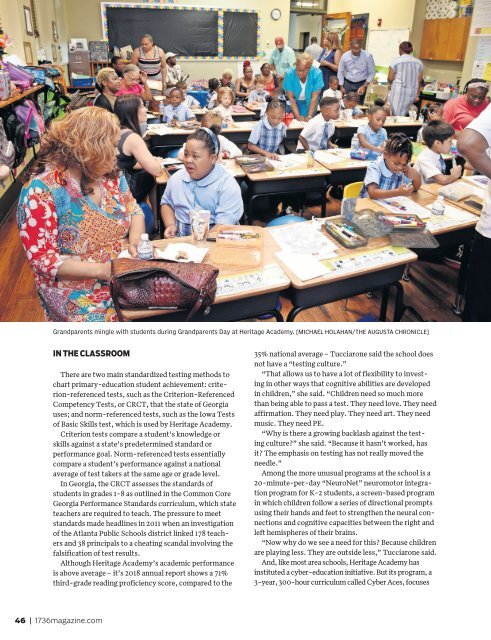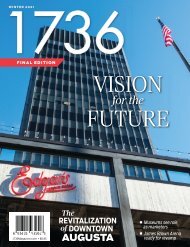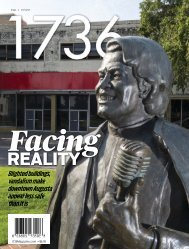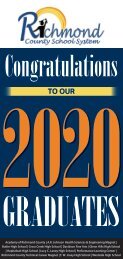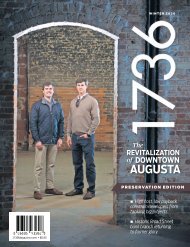Education Edition - 1736 Magazine, Fall 2019
- No tags were found...
You also want an ePaper? Increase the reach of your titles
YUMPU automatically turns print PDFs into web optimized ePapers that Google loves.
Grandparents mingle with students during Grandparents Day at Heritage Academy. [MICHAEL HOLAHAN/THE AUGUSTA CHRONICLE]<br />
IN THE CLASSROOM<br />
There are two main standardized testing methods to<br />
chart primary-education student achievement: criterion-referenced<br />
tests, such as the Criterion-Referenced<br />
Competency Tests, or CRCT, that the state of Georgia<br />
uses; and norm-referenced tests, such as the Iowa Tests<br />
of Basic Skills test, which is used by Heritage Academy.<br />
Criterion tests compare a student’s knowledge or<br />
skills against a state’s predetermined standard or<br />
performance goal. Norm-referenced tests essentially<br />
compare a student’s performance against a national<br />
average of test takers at the same age or grade level.<br />
In Georgia, the CRCT assesses the standards of<br />
students in grades 1-8 as outlined in the Common Core<br />
Georgia Performance Standards curriculum, which state<br />
teachers are required to teach. The pressure to meet<br />
standards made headlines in 2011 when an investigation<br />
of the Atlanta Public Schools district linked 178 teachers<br />
and 38 principals to a cheating scandal involving the<br />
falsification of test results.<br />
Although Heritage Academy’s academic performance<br />
is above average – it’s 2018 annual report shows a 71%<br />
third-grade reading proficiency score, compared to the<br />
35% national average – Tucciarone said the school does<br />
not have a “testing culture.”<br />
“That allows us to have a lot of flexibility to investing<br />
in other ways that cognitive abilities are developed<br />
in children,” she said. “Children need so much more<br />
than being able to pass a test. They need love. They need<br />
affirmation. They need play. They need art. They need<br />
music. They need PE.<br />
“Why is there a growing backlash against the testing<br />
culture?” she said. “Because it hasn’t worked, has<br />
it? The emphasis on testing has not really moved the<br />
needle.”<br />
Among the more unusual programs at the school is a<br />
20-minute-per-day “NeuroNet” neuromotor integration<br />
program for K-2 students, a screen-based program<br />
in which children follow a series of directional prompts<br />
using their hands and feet to strengthen the neural connections<br />
and cognitive capacities between the right and<br />
left hemispheres of their brains.<br />
“Now why do we see a need for this? Because children<br />
are playing less. They are outside less,” Tucciarone said.<br />
And, like most area schools, Heritage Academy has<br />
instituted a cyber-education initiative. But its program, a<br />
3-year, 300-hour curriculum called Cyber Aces, focuses<br />
46 | <strong>1736</strong>magazine.com<br />
1117_T_44_AM____.indd 46<br />
10/25/<strong>2019</strong> 12:23:46 PM


